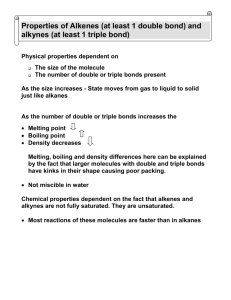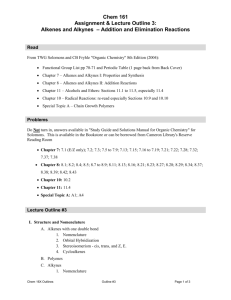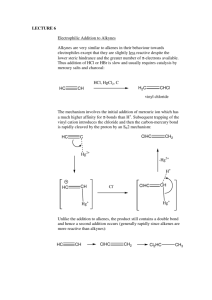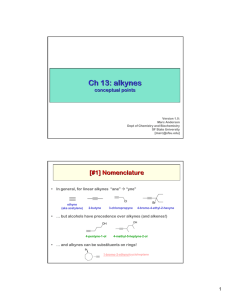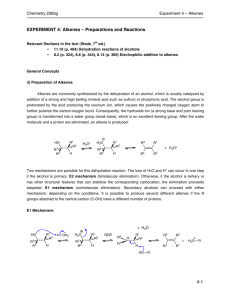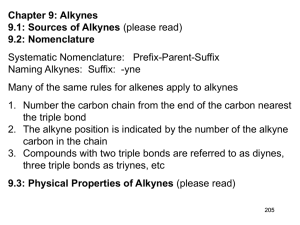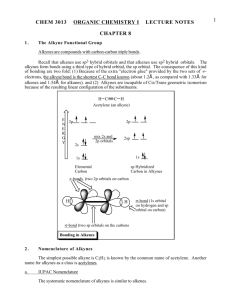Alkene & Alkyne Functional Group Tests: Organic Chemistry
advertisement
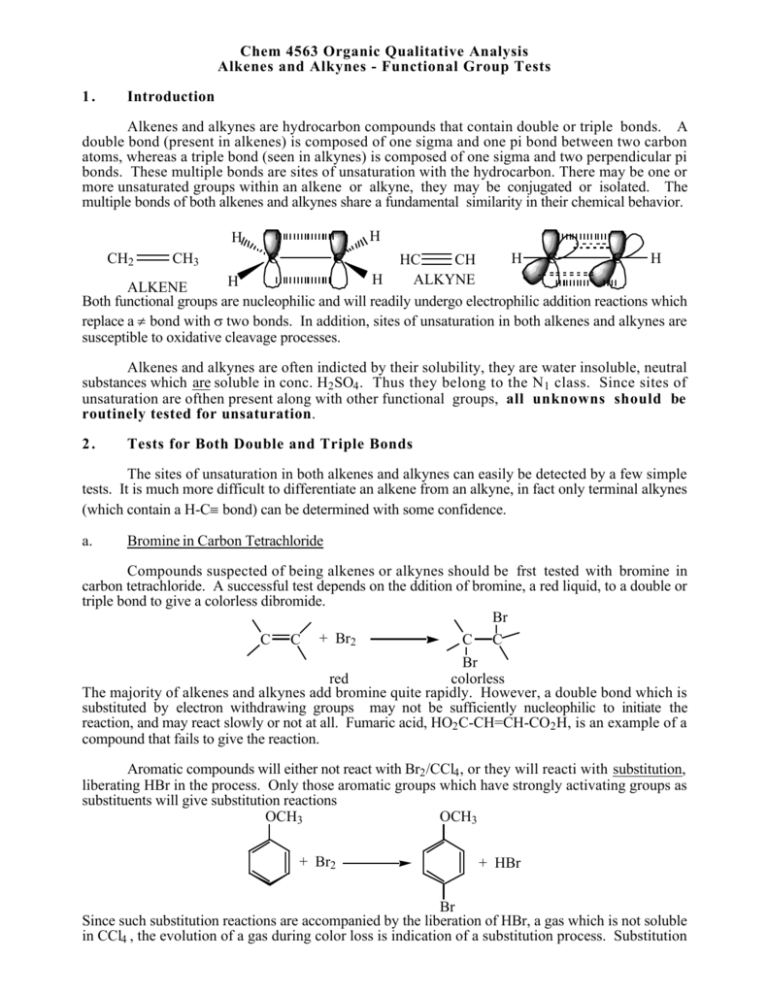
Chem 4563 Organic Qualitative Analysis Alkenes and Alkynes - Functional Group Tests 1. Introduction Alkenes and alkynes are hydrocarbon compounds that contain double or triple bonds. A double bond (present in alkenes) is composed of one sigma and one pi bond between two carbon atoms, whereas a triple bond (seen in alkynes) is composed of one sigma and two perpendicular pi bonds. These multiple bonds are sites of unsaturation with the hydrocarbon. There may be one or more unsaturated groups within an alkene or alkyne, they may be conjugated or isolated. The multiple bonds of both alkenes and alkynes share a fundamental similarity in their chemical behavior. H H CH2 CH3 C C H C C H HC CH H ALKYNE H ALKENE Both functional groups are nucleophilic and will readily undergo electrophilic addition reactions which replace a π bond with σ two bonds. In addition, sites of unsaturation in both alkenes and alkynes are susceptible to oxidative cleavage processes. Alkenes and alkynes are often indicted by their solubility, they are water insoluble, neutral substances which are soluble in conc. H2 SO4 . Thus they belong to the N 1 class. Since sites of unsaturation are ofthen present along with other functional groups, all unknowns should be routinely tested for unsaturation. 2. Tests for Both Double and Triple Bonds The sites of unsaturation in both alkenes and alkynes can easily be detected by a few simple tests. It is much more difficult to differentiate an alkene from an alkyne, in fact only terminal alkynes (which contain a H-C≡ bond) can be determined with some confidence. a. Bromine in Carbon Tetrachloride Compounds suspected of being alkenes or alkynes should be frst tested with bromine in carbon tetrachloride. A successful test depends on the ddition of bromine, a red liquid, to a double or triple bond to give a colorless dibromide. Br C C + Br2 C C Br red colorless The majority of alkenes and alkynes add bromine quite rapidly. However, a double bond which is substituted by electron withdrawing groups may not be sufficiently nucleophilic to initiate the reaction, and may react slowly or not at all. Fumaric acid, HO2 C-CH=CH-CO2 H, is an example of a compound that fails to give the reaction. Aromatic compounds will either not react with Br2 /CCl4 , or they will reacti with substitution, liberating HBr in the process. Only those aromatic groups which have strongly activating groups as substituents will give substitution reactions OCH3 OCH3 + Br2 + HBr Br Since such substitution reactions are accompanied by the liberation of HBr, a gas which is not soluble in CCl4 , the evolution of a gas during color loss is indication of a substitution process. Substitution reactions accompanied by liberation of hydrogen chloride gas occur with phenols, amines, enols, aledhydes, ketones and other compounds with active methylene groups. b. Permanganate Oxidation Test The multiple bonds of alkenes are readily oxidized to diols using a potassium permanganate solution. Alkynes are oxidized to carboxylic acids. This test depends on the conversion of the purple permanganate ion (MnO4 -) to a brown precipitate of manganese dioxide (MnO2 ) following the oxidation of the unsaturated compound. OH OH + MnO2 C C + MnO4 C C brown purple The speed with which the unsaturated compound decolorizes the permanganate solution depends on the solubility of the compound in water. If the compound is very insoluble, it is necessary to powder the compound and shake the mixture vigorously for several minutes, or to dissolve the substance in a water miscible solvent which is unaffected by permanganate (try ethers such as ethyl ether or THF). Any easily oxidizable compound such as 1˚ and 2˚ alcohols, aldehydes, phenols and aromatic amines will also give a positive permanganate test. For this reason, neither the bromine test nor the permanganate test is a stand alone test. Alkenes/Alkynes are indicated only when a positive result is obtained for both tests. 2. Test for Terinal Alkynes There are two types of alkynes, terminal and internal. Like alkenes, both types add bromine and are oxidized by permanganate. There are few general functional group tests available for alkynes, however there is one test for terminal alkynes, the formation of metal derivatives. a. Mercury Derivatives When a terminal alkyne is added to to basic mercuric iodine reagent, an immediate white or gray-shite precipitate forms. This reagent may be used as a convenient test for terminal alkynes, as well as a method of preparation of derivatives for further characterization. NaOH 2 R C C H + K2HgI4 R C C 2 Hg Certain heavy-metal acetylides are explosive when dry and should therefore be handled only in small quantities.




